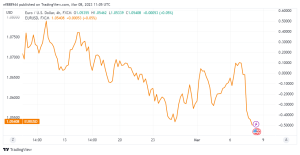The EURUSD is Trading at two-month lows.
The EURUSD is consolidating at two-month lows below 1.0550. Extending the previous day’s decline in early Europe. The pair is still being pushed down by Fed Chair Powell’s hawkish language. Which has contributed to broad-based US Dollar appreciation, and by Germany’s poor Retail Sales data. After reaching its lowest level since early January at 1.0525 during Asian trading hours. EURUSD staged a minor comeback at 1.0550 in the European morning on Wednesday. The technical prognosis for the pair indicates that sellers remain in command. If the ADP Employment Change data from the United States comes in substantially lower than predicted. The EURUSD might continue its rebound.
On Tuesday, he told the US Senate Banking Committee. “if the totality of incoming evidence shows that quicker tightening is needed, we are prepared to raise the pace of rate hikes.” in the EURO.
A stronger-than-expected result, on the other hand, is likely to weigh on risk sentiment and assist the US Dollar maintain its footing in the second part of the day. Powell is scheduled to appear before the House Financial Services Committee later in the day and is likely to make the same prepared remarks.
As a result, his remarks should not add anything to what markets saw on Tuesday. It’s also worth noting that Powell’s hawkish tone appears to be influencing (ECB) rate rise forecasts. According to Reuters, markets believe there is a 65% chance that the ECB’s terminal rate will be 4.25% this year, up from 4.00% last week. Hawkish ECB bets may help the Euro minimize its decline.
EURUSD Technical Outlook
The EURUSD pair appears to have established at 1.0530. Further losses approaching 1.0500 (psychological threshold), 1.0480 (2023-low), and 1.0450 (static level from December) might be seen with a four-hour closing below that level.

1.0560 (previous support, static level) serves as starting resistance before 1.0580. (static level). If the latter barrier fails, buyers may show interest, and EUR/USD may continue to fall towards 1.0600/1.0610 (static level, 50-period Simple Moving Average (SMA) on the four-hour chart).









